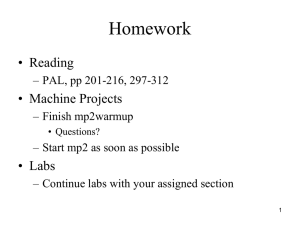Name: Directions: Work only on this sheet (on both sides, if needed
advertisement
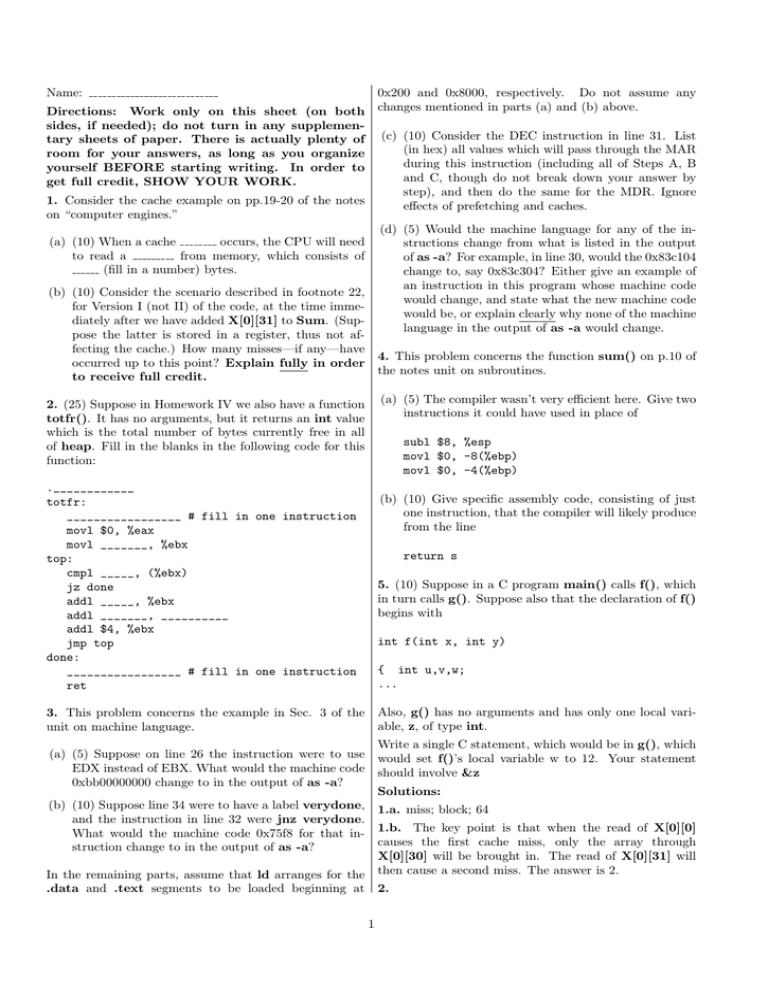
Name:
0x200 and 0x8000, respectively. Do not assume any
changes mentioned in parts (a) and (b) above.
Directions: Work only on this sheet (on both
sides, if needed); do not turn in any supplementary sheets of paper. There is actually plenty of
room for your answers, as long as you organize
yourself BEFORE starting writing. In order to
get full credit, SHOW YOUR WORK.
(c) (10) Consider the DEC instruction in line 31. List
(in hex) all values which will pass through the MAR
during this instruction (including all of Steps A, B
and C, though do not break down your answer by
step), and then do the same for the MDR. Ignore
effects of prefetching and caches.
1. Consider the cache example on pp.19-20 of the notes
on “computer engines.”
(d) (5) Would the machine language for any of the instructions change from what is listed in the output
of as -a? For example, in line 30, would the 0x83c104
change to, say 0x83c304? Either give an example of
an instruction in this program whose machine code
would change, and state what the new machine code
would be, or explain clearly why none of the machine
language in the output of as -a would change.
(a) (10) When a cache
occurs, the CPU will need
to read a
from memory, which consists of
(fill in a number) bytes.
(b) (10) Consider the scenario described in footnote 22,
for Version I (not II) of the code, at the time immediately after we have added X[0][31] to Sum. (Suppose the latter is stored in a register, thus not affecting the cache.) How many misses—if any—have
4. This problem concerns the function sum() on p.10 of
occurred up to this point? Explain fully in order
the notes unit on subroutines.
to receive full credit.
(a) (5) The compiler wasn’t very efficient here. Give two
instructions it could have used in place of
2. (25) Suppose in Homework IV we also have a function
totfr(). It has no arguments, but it returns an int value
which is the total number of bytes currently free in all
of heap. Fill in the blanks in the following code for this
function:
subl $8, %esp
movl $0, -8(%ebp)
movl $0, -4(%ebp)
.____________
totfr:
_________________ # fill in one instruction
movl $0, %eax
movl _______, %ebx
top:
cmpl _____, (%ebx)
jz done
addl _____, %ebx
addl _______, __________
addl $4, %ebx
jmp top
done:
_________________ # fill in one instruction
ret
(b) (10) Give specific assembly code, consisting of just
one instruction, that the compiler will likely produce
from the line
return s
5. (10) Suppose in a C program main() calls f(), which
in turn calls g(). Suppose also that the declaration of f()
begins with
int f(int x, int y)
{ int u,v,w;
...
3. This problem concerns the example in Sec. 3 of the Also, g() has no arguments and has only one local variable, z, of type int.
unit on machine language.
Write a single C statement, which would be in g(), which
(a) (5) Suppose on line 26 the instruction were to use would set f()’s local variable w to 12. Your statement
EDX instead of EBX. What would the machine code should involve &z
0xbb00000000 change to in the output of as -a?
Solutions:
(b) (10) Suppose line 34 were to have a label verydone, 1.a. miss; block; 64
and the instruction in line 32 were jnz verydone.
What would the machine code 0x75f8 for that in- 1.b. The key point is that when the read of X[0][0]
causes the first cache miss, only the array through
struction change to in the output of as -a?
X[0][30] will be brought in. The read of X[0][31] will
In the remaining parts, assume that ld arranges for the then cause a second miss. The answer is 2.
.data and .text segments to be loaded beginning at 2.
1
# make totfr accessible from the C code
.globl totfr
totfr:
# save old EBX, since we will write to it
pushl %ebx
movl $0, %eax
# map contains the locations and sizes
# of the free chunks, so point
# EBX to it
movl $map, %ebx
top:
# map uses -1 as a termination signal
cmpl $-1, (%ebx)
jz done
# no termination, so move to the next
# element of map, which gives the
# size of this free chunk
addl $4, %ebx
# read that size
addl (%ebx), %eax
# go to the next element of map, which
# we will check for termination
addl $4, %ebx
jmp top
done:
# restore old EBX
popl %ebx
ret
ret
(The question was misstated. It should have asked for
two instructions, the second of which was ret. So, the
grading here was liberal.)
Note that
movl s, %eax
will NOT work. Local variables are stored on the stack,
not in the .data segment.
5.
*(&z+3) = 12;
Here is a picture of the stack at the time we are exectuing
g():
z
saved EBP
return address
w
v
u
saved EBP
return address
x
y
3.a. 0xba00000000
3.b. 0x7506
As you can see, the address of w is 12 bytes more than
3.c. The instruction is fetched. Since it is in offset 0x14 that of z. However, &z is considered a pointer, so pointer
of the .text segment, which itself begins at 0x8014, the arithmetic is used, hence the expression &z+3.
CPU will put 0x8014 in the MAR. The memory will then
send back the contents of that location, i.e. the instruction, 0x48, which the CPU will receive in the MAR. The
instruction itself doesn’t access memory, so this is the end
of activity in MAR/MDR for this instruction.
3.d. As pointed out in the notes, any machine code which
the assembler had tentatively filled with an offset must
be changed by the linker to the actual address of the
item in question. The instruction at offset 0x27 the .text
segment will change to 0xb900200000, because x, which
had been at offset 0 of the .data segment, will be at
absolute location 0x200 + 0 = 0x200. The instruction at
offset 0x33 will change to 0x891d10200000. (The linker
will place these two instructions at 0x8027 and 0x8033,
but this is irrelevant to the question.)
4.a.
pushl $0
pushl $0
4.b.
movl -8(%ebp), %eax
2
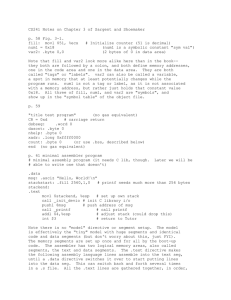
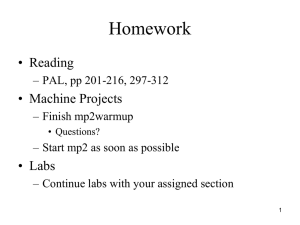
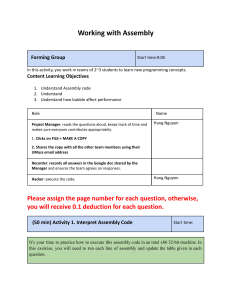
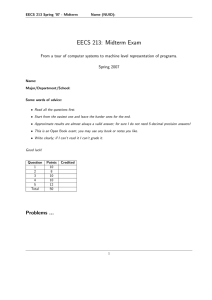
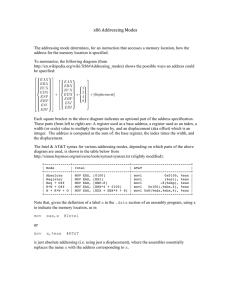
![MA1S12 (Timoney) Tutorial sheet 7b [March 10–14, 2014] Name: Solutions](http://s2.studylib.net/store/data/011008030_1-c04da3e7c2d74dfcf07e513d17d7896f-300x300.png)
